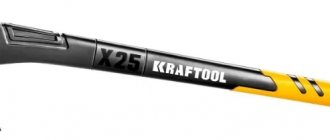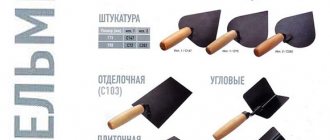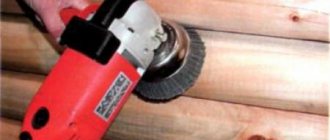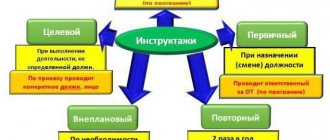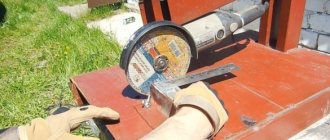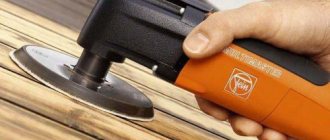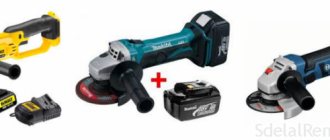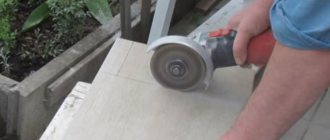Operations that can be performed with a grinder
The shredder is a multifunctional tool. The driving mechanism in it is an electric motor, which through a gearbox transmits movement to a shaft with a replaceable nozzle installed on it. The general view of the device is shown in the photo below.
There are models on the market that differ in power and design:
Angle grinder (grinder) FT-1318
Professional large grinding machine 230 mm Stern AG230B
Powerful devices are powered by a three-phase voltage of 380 V, and household devices are powered by a single-phase 220 V network. There are also low-power battery models.
Angle grinder (angle grinder) can be made of different materials as follows the main types of work:
- cutting;
- Grinding;
- Polishing.
The angle grinder is designed to work with the following materials:
- Concrete;
- Metal;
- Tree;
- Glass;
- Ceramic tile;
- Stone;
- Brick;
- Plastic.
Grinding machines are widely used both in everyday life and in industrial settings. This is due to their wide functionality due to the following factors:
- A good selection of different attachments made of different materials to perform different operations;
- Possibility of fixed fixation using special fasteners;
- Some models have additional handles and several speed modes.
In this case, keep in mind that only special discs are used to process each material.
Reasons why brushes spark
Very often you can notice how the brushes on an angle grinder sparkle. Signs of sparking are detected through the ventilation holes in the body of the power tool. Craftsmen are interested in why the brushes on an angle grinder spark, even after they have been directly replaced. There are many reasons for this, and to understand this, you need to have an understanding of the structure of a power tool. If you know how the angle grinder works inside, then understanding why the brushes spark strongly will not be difficult.
The reasons for strong sparking of brushes on grinders are the following factors:
- Faulty armature winding. If a violation of the insulation of the armature winding occurs, then this ultimately contributes to the development of an interturn short circuit, as well as a short circuit to the core. In addition, a winding break may occur, which will ultimately cause an increase in load. A characteristic sign of a faulty armature winding is a decrease in speed, an increase in noise and a drop in power
- The brushes do not press well to the commutator. A spring is responsible for pressing the main part, which, over time, loses its original springing properties.
- The rotor winding has broken off from the copper plate of the commutator - this phenomenon is extremely rare, however, if the power tool is overloaded, it may well occur
- The centering of the electric motor armature is disrupted, which ultimately contributes to strong sparking of the brush on the angle grinder
- The shape of the collector is broken. The collector, consisting of copper lamellas, has a cylindrical shape, which can be broken when the rotor is rewinding. At the slightest deformation of the commutator shape, sparking of the brushes will occur
- Violation of insulation between the collector lamellas. Each collector plate is insulated from each other, and if the micanite insulating layer is damaged, sparking occurs. The insulation between the plates may also be compromised due to the settling of the graphite layer in the grooves
- When the armature bearings are worn. If the bearings are faulty, then a beating of the rotating armature occurs, and as a result, signs of sparking appear
- Curvature of the rotor shaft. It is difficult to bend it, but if this happens, the engine begins to work under load. To prevent the tool from malfunctioning, it is recommended to replace the rotor
- If the ends of the armature windings are soldered incorrectly to the copper plates of the collector. Such errors are not allowed at the factory, but they can be made by the wrapper who rewinds the armature of the power tool.
- Inappropriate composition of graphite brushes. The parts in question are made from coal and graphite, adding different types of impurities. This is done for a reason, but in order to use brushes depending on the voltage and shaft rotation speed. Graphite can be soft or hard. The lower the supply voltage, the softer the grade of graphite selected. For high-voltage power tools, it is necessary to take hard brushes that do not contain copper.
- Deformation of the lamellas due to their heating. If the angle grinder experiences excessive loads, deformation of one or more lamellas of the collector may occur. The plates rise relative to the others, resulting in the contact being broken. This malfunction causes strong sparking of the brushes when operating the power tool.
- Poor contact at the brush connection point. If the terminal is loosely connected to the device, the result of this contact failure may manifest itself in the form of excessive sparking
- Presence of carbon deposits on copper plates - periodically or regularly it is recommended to clean the surface of copper lamellas from carbon deposits. Carbon deposits usually appear due to wear of the brushes, so if blackening is detected on the surface of the commutator, it should be wiped with alcohol
Often, after changing the brushes on an angle grinder, craftsmen observe the phenomenon of excessive sparking. Based on the factors described above, you can identify the cause and eliminate it before the tool fails. The elements in question are inexpensive, but due to their incorrect selection and use, the power tool may break. To find out what malfunction is causing strong sparking, you will need to disassemble the power tool and inspect it, as well as ring the rotor winding.
What are the dangers of an angle grinder?
Angle grinder. Traumatic instrument. This is due to the following reasons:
- High speed of rotation of the working nozzle. It exceeds 10,000 rpm;
- Openness (insecurity of the case) of most of the disk;
- The ability to break the abrasive disc into fragments of different sizes, which in this case fly at considerable speed;
- Frequent inability to properly organize the workplace;
- Formed when cutting metal (or other material) or grinding small particles.
When the disc is stuck, which happens even due to its slight curvature, the sharpener is almost impossible to hold in your hands, especially for a powerful tool. This is due to the high speed of the nozzle. Therefore, beginners are recommended to work with low-power models equipped with disks with a diameter of 115-125 mm. The latter must be free from the slightest defects, which could lead to their sudden destruction and separation of the angle grinders from the hands with uncertain consequences.
Why do many who work as grinders cut on their own?
There are several answers here. Firstly, a person does not know how to work with an angle grinder; this is the first time in his life that he has picked up this tool. Logically, sparks from the grinder should not fly towards the worker, since this will burn his pants faster, and if the disc flies apart, it will fly straight to his feet.
Therefore, the one who does not know takes a grinder and cuts from himself. However, this is the first and most serious mistake. Trying to save his pants, he thereby exposes himself to danger, because it becomes simply impossible to hold the grinder when the disk jams.
What ends up happening? When the disk jams or balance is lost, the body moves by inertia after the rotating circle, and this is where trouble can happen. Without holding the grinder in your hands, or even holding it, but not completely, you can get seriously injured.
In simple words, when cutting with a grinder away from you, only one hand is involved in holding the tool. If you work with an angle grinder on yourself, then in addition to your hands, your body and legs are connected, so it becomes much easier to hold the tool.
General safety rules
To reduce the risk of injury when operating a sander, this tool must be used correctly. The following rules of use must be observed:
- Must use personal protective equipment. The operator's health must be in good condition.
- Before starting work, it is necessary to check that the casing is fastened correctly and securely so that it does not fall out during the process and sparks do not fly away to the operator.
- Use only complete discs without defects (cracks, chips, cracks) and strictly for the purpose of processing a specific material.
- A protective screen must be located between the operator and the circle so that there is protection if the latter is destroyed.
- Before starting work, it is necessary to check the serviceability of the tool at idle speed for about 1 minute: uniform rotation at maximum speed, no vibration.
- Before use, inspect all attachments to determine their suitability for use.
- It is necessary to protect items that could ignite from asbestos sparks or ordinary damp cloth: greasy cloth, fuel and lubricants, paper, solvents, ropes.
- Always reliable to fix working attachments so they don't fly off.
- If it is possible to control the rotation speed, set the speed recommended for cutting or sanding the workpiece.
- The tree is cut very carefully, since falling on a branch can cause the tool to be torn out of your hands.
- It is forbidden to install nozzles from a circular saw, because they are designed for different spindle speeds.
- Requires holding the tool with both hands.
- Before starting work, you must remove everything unnecessary and make sure that there are no objects on the cutting plane other than the workpiece.
- Take regular breaks from work.
- If a workpiece gets stuck, turn off the tool immediately.
- It is necessary to maintain a stable (equilibrium) body position.
- Power cord Keep away from the rotating part to avoid cutting it or causing a short circuit.
- Only after the wheel has completely stopped can you release the tool from your hands.
- When navigating the work site, the mill must be turned off, and this should also be done when the power supply is disconnected.
- You only need to cut at full speed.
READ How to Cut Paving Slabs with a Grinder
The specified safety measures were developed by manufacturers of angle grinders, as well as special organizations (services) dealing with occupational safety issues.
A person working with a coffee grinder must be adequate and have a balanced psychological state.
Used protective equipment
When working with an angle grinder, the user must wear the following personal protective equipment:
- A medical mask or goggles that cover the eyes from all sides;
- Gloves made of thick fabric or leather;
- Special shoes (all, stable) and work clothes;
- A gas mask that will provide protection against the penetration of small particles into the respiratory system when cutting concrete, glass or ceramic tiles, brick, porcelain, foam, stone and other dusty materials.
The use of protective equipment is mandatory when working with a coffee grinder. This helps you work safer.
Rules for safe work with an angle grinder
To reduce the risk of injury to yourself and others, the master needs to follow several recommendations. Don’t forget that in addition to sparks, a pinched disc poses a danger. In this case, the tool can simply be torn out of the person’s hands. It is difficult to guess where an angle grinder with discs rotating at high speed will fly. The consequences of such an accident are the saddest - chopped pieces of flesh, etc.
From the editor - this is interesting! The angle grinder was invented in 1954 in Germany. And the colloquial name “grinder” arose in the Soviet Union in the 70s, when the first instruments appeared. After all, they were released in Bulgaria. Only in the countries of the USSR was an angle grinder called a grinder, nowhere else.
Correct position of the adjustment knob
How to protect yourself and your neighbors from a flood in your apartment, important advice from an experienced plumber
The handle is placed on top. Not from the side or below, but vertically. In this position, the master provides a strong and tight grip, and will be able to protect himself and people from the consequences of “biting” the disc. In addition, sparks fly to the side, which also ensures safe operation.
The lateral position of the handle is used for grinding work.
Disc rotation direction
By making a cut away from you, the master does not get caught in a stream of sparks, so most often beginners position the grinder this way. But experienced people know that the casing will protect the master from sparks - they are not as dangerous as a disk clamp. When the cut is directed away from you, the looped angle grinder will, by inertia, fly towards the master - and this is a guarantee of injury.
When cutting towards yourself and the angle grinder’s disk is slightly rotated, when “biting”, it will fly away from the master, to the ground.
Material placement when cutting
If a pipe or sheet of metal is fixed on both sides and sawed between the fasteners, this is a mistake. This action often results in the blade jamming at the end of the cut. Therefore, one end should always be suspended. At the same time, at the end of cutting, the process of “uncompressing” the material occurs, the disk will not jam. Sparks in this position of the material go away from the master.
Additional tightening of the nut
Do-it-yourself relief plaster, advice from professionals
Tightening the nut is a waste of time. During operation, the bolt itself is tightened to the required level, so when starting work, simply tightening the nut with your fingers will suffice.
If you tighten the nut with a wrench, then it is very difficult to unscrew it. The angle grinder start button is pressed only when the disc is freely moving, that is, you cannot plunge the saw into the cut before the rotation cycle starts.
How not to use a sander
Safety should come first when using angle grinders. Accordingly, it is prohibited:
- Perform work manipulations without PPE;
- Works in light clothing that does not completely cover the body (arms, legs);
- Use a machine that is not equipped with a spark guard;
- Without checking the serviceability of the tool at idle, start using it;
- The disk is faulty or not suitable for the material;
- Located in the plane of the cut;
- Press the tool firmly;
- Work so that the direction of rotation of the circle is in the direction of the operator;
- Do your work without interruptions because your arms are tired and the shredder is difficult to hold;
- That the workpiece was not fixed (for example, in a vice or clamps);
- Sharpen the metal parts on the side surface of the disk;
- Cut workpieces whose thickness exceeds half the radius of the circle used;
- Presence of strangers in the work area;
- Touch the nozzles until they are cool, as they become very hot during cutting and sanding due to friction;
- When deepening the circle, insert the tool into the workpiece;
- Grind into thin discs;
- Use attachments larger than the intended angle grinder;
- Position the workpiece so that the cutting occurs while the wheel is clamping (the cut should be at fracture, not compression).
Safety precautions
Violation and non-compliance with safety regulations leads to serious injuries. Therefore, before starting work, you must carefully study the instructions, remember and follow them. A violation of safety regulations is working without protection and drinking on oneself. This is simply beyond comprehension. The stance should be correct, legs bent at the knees, grinder slightly to the side.
A grinder is a working tool that can be dangerous. The unit must be positioned towards you, with the heel. The head should never be on the cutting line. And in this regard, it is correct to shoot sparks from yourself or under a person, that is, at the legs, because:
- You can see where the sparks are flying,
- The likelihood of catching sawdust or sawdust in the eye is reduced, even when working with glasses, it can fly into the air.
- When a disk flies apart (this happens), the fragments move away from themselves, and not towards a person.
How to cut a coffee grinder
Before you start cutting material, you need to understand which direction you want the sander to spin: spark away or spark away. There is no single answer among users; they work both ways. If the nozzle is rotated counterclockwise, the sparks (as well as the broken circle) fly out in the opposite direction from the operator, but the tool will return to the user when jammed. In the second case, the opposite happens. For safety purposes, proper rotation is considered to occur when the sparks are flying toward the operator, because when jammed, the tool will jerk in the opposite direction.
In any case, manufacturers recommend directing the movement of the angle grinder and the rotation of its wheel in one direction. This greatly reduces the chance of the drive slipping out of the slot during operation. But with this method, the markings on the material are often hidden by flying sparks.
Changing the rotation of the nozzle You can by moving the handle and cover on the other side. This is the simplest option (if possible). A more complex way is to make changes to the electrical circuit of the device. But this doesn't always help.
When cutting, it is necessary that the working plane does not change and there is no distortion. Discs must be used in accordance with the material being processed. Thus, concrete, tiles, and stone are cut with diamond-coated circles of different diameters.
READ How to Replace Brushes on a Grinder
Which side should you put the disc on the grinder?
Which side to place the cutting disc on may depend on several factors. Firstly, if the disk is not flat, then there is only one way to place it and the question disappears by itself. Secondly, if the circle is still flat, you can focus on the label - if the grinder rotates away from itself, then it is installed with the label inward, if towards itself, then, accordingly, outward. If this principle is not followed, then you can expect undesirable results - breakage of the disk during the sawing process or simply its rapid wear.
As for which direction the disc on the angle grinder rotates, this is primarily a safety issue. It is believed that it is necessary to cut concrete in the direction of rotation of the disk or towards itself. In an ideal position, sparks should fly to the side to the left of the person working with the tool. If this cannot be done, then you can use another position when the sheaf of sparks is directed downwards. In any case, a situation should not be allowed where sparks fly from the user, since in the event of a sudden jamming of the disk, the angle grinder will be directed towards him.
In other words, cutting materials against the direction of rotation of the disk or away from yourself is extremely unsafe, since in the case of a wedge, there is a sharp ejection of the angle grinder in the direction of the person working. By the way, if additional questions arise regarding how to install a disk on an angle grinder, you can also watch training videos, of which there are more than enough on the Internet today.
If you have any questions or need advice on changing and installing disks, just leave a request on the website or call the specified contact phone number, and our specialists will tell you how to proceed correctly. The entire range of our diamond blade products is presented in the diamond blades section.
The nuances of cutting some materials
When cutting concrete, meet the following recommendations:
- Before starting work, check for the presence of pipes, fittings, and electrical wiring built into the concrete (using a metal detector or tools for searching for electrical wiring);
- To reduce dust, moisten the working surface with water (for example, from a spray bottle or brush);
- Periodically cool the cutting element with air or water.
In the absence of a tile cutter, the tile sander also cuts the tile. Experts cut uniform circles onto tiles. Cut stone and tiles in two ways:
- Wet (moisten the work area with water);
- Dry (no moisture).
In the first case, cooling improves, but the dirt remains, and in the second, a lot of dust is released. The wet method is used for large volumes of future work, and the dry method is used for one-time cutting.
Any material must be cut so that the disc sinks into it with little pressure, almost exclusively under the influence of its own weight. This is necessary to prevent disk deformation and reduce the likelihood of jamming. If the process slows down, it is necessary to replace the nozzle with a new one.
Use the sander in accordance with the operating instructions and safety instructions. The working part must rotate in the direction of movement of the tool. Be sure to turn on the device in standby mode before starting the process. In this case, there should be no vibration, heating of the grinding machine, as well as extraneous sounds from it. The circles must be used without damage. The most dangerous factor. This is a comeback. To avoid this, you should avoid jamming the wheels when cutting materials due to malfunction.
Source
How to prevent sparks from getting in?
Preventing marks from an angle grinder is much easier than getting rid of them. If possible, surfaces that may be damaged should be covered with thick fabric - tarpaulin or jeans. And yet, it is not always possible to protect the entire surrounding area from the effects of sparks.
To protect nearby objects from sparks, you can glue any small object (emery cloth, piece of metal, thick plastic, etc.) to the protective casing of the angle grinder. You should glue only in the direction of the flow of sparks and it is better to use silicone glue, which is easier to tear off.
When working with an angle grinder, it is important to remember that the traces left behind by it can spoil the appearance of the decor of the room in which the work is being carried out. And take measures to prevent this from happening.
Bulgarian. What kind of animal is this?
Angle grinder (angle grinder). This is the name of a tool that many people know as a sander. The first models of this instrument in the USSR began to be produced in Bulgaria at the Altos-Bulgaria enterprise. The first grinding machines were produced only as grinders; later, angle grinders became more functional and almost indispensable in construction and metalworking.
From the outside, the grinder looks quite simple and unpretentious: a cylindrical body with a handle on one side and a handle on the other. Side handle (not required) and bit holder. The attachments are what make the angle grinder such a multi-functional tool. All nozzles are mounted on the spindle, and the discs are always additionally secured with a flange and a clamping nut. This is necessary when working with a sander.
Modern angle grinders can cope with many tasks: grinding and polishing surfaces, cutting stone, tiles, glass, concrete, plywood, metal and brick, and if necessary, even a slice of sausage can be cut into shapes, the main thing is to choose the right attachment. Keep in mind that each type of work and workpiece has its own abrasive tool.
Replacement attachments for the chopper are presented in the following assortment:
- Brushes. For cleaning and polishing surfaces. You can remove rust from metal or polish welds.
- Circles. The use of circles depends on their composition. Some can cut metal, others. Only ceramics. All this can be found in the instructions on the packaging and on the disc itself.
Various not only removable attachments, but also shredders. They are household, professional and industrial. The home remedy can be used for no more than 40 minutes and not every day. A professional Bulgarian can work several hours a day, while an industrial Bulgarian... A real workaholic. Can work almost tirelessly. Differences can also be found in the appearance of the tool: sanders with one handle, with two handles and with vibration-absorbing handles.
Chemical cleaning methods
A noticeably better result can be achieved using chemical methods. The damaged area should be covered with table acetic acid (70%) for several minutes. Over time, the iron will oxidize and it will be very easy to remove it with a thin needle, or simply by running a sponge over the surface. Instead of vinegar, you can use acidic detergents such as Cilit Bang. However, you should be careful, since their composition is more aggressive than vinegar, and can have a detrimental effect on the surface.
When working with any acid, it is important to remember to protect your hands and respiratory tract!
Unfortunately, sparks that land on the tile burn through the outer layer of glaze, and after they are removed, there will be potholes in the tile that cannot be removed.
Safety or how to properly operate a mill
Before starting the work process, you need to prepare the coffee grinder: select and install the wheel. The motor power of an angle grinder requires a certain wheel size. The smaller the diameter of the circle, the higher its speed, and vice versa, the larger the disc, the less it can work. Improper use can lead to rapid tool wear, nozzle deformation and other undesirable consequences.
Deformed attachments are not suitable for use. You must get rid of circles with cracks, potholes and other deviations from the normal shape. After successfully locking the wheel, the grinder is tested in standby mode. You need to plug in the tool and run it at maximum speed for one minute. If you do not hear any unnecessary vibrations or sounds, and the protective cover does not touch the disc, the instrument is ready to use.
READ Which Grinder Is Better For Tiles
It is also necessary to prepare the person who will operate the coffee grinder. The angle grinder has a safety cover that is designed to protect against sparks and debris from the blade if it explodes. But the coverage will not provide complete protection against injury. Therefore you should wear:
- Protective mask or goggles;
- Overalls;
- Narrow gloves;
- Respirator.
There are also a few things to keep in mind:
- Do not leave jewelry on your body (such as a bracelet or watch) that can be wrapped around the circle;
- You cannot work in a state of fatigue or illness, in a state of poisonous or narcotic intoxication AL-KO;
- Do not use wooden saws on the sander;
- Cannot be in the cutting plane;
- Do not let go of the tool until it completely stops rotating;
- Do not touch the equipment until it has cooled down after use;
- Flammable items: rags, ropes, fuel, solvents, etc.;
- Don't forget to keep a first aid kit nearby.
Securing parts is an important aspect of proper operation of a sander. Everything that is cut and processed must be firmly fixed. The only exceptions are elements that guarantee the property with their weight (stones, slabs, etc.). The part can be secured in a vice or used with a Partner, which, for example, holds a pipe or other workpiece with an adjustable wrench. A correctly positioned part should not have any sagging in the cutout area.
No TB. Death by grinder - part 2
a man with a whole angle grinder in his stomach.
If I'm not confusing anything, this man worked "with sparks for himself"
Not a fact at all!!!
The fastest way is just the opposite! For example: a worker cuts a strip of sheet (or other material) horizontally in a vice, the part that sticks out on the right from the jaws of the vice. The left handle of the grinder is directed toward the worker’s abdomen, the body of the grinder’s motor is directed to the right of the worker, “sparks from itself.” It seems like it’s convenient to work... and sparks don’t interfere... Only the outstretched left hand (and the right one too) has poor control of the grinder - the recoil force of the grinder is directed at the worker, and the feed of the grinder practically has to be across his arms (extremely unstable!!!). Trying to compensate for instability, the worker moves to the left (bending his left arm) and, if the disc is possibly bitten, he turns the grinder in his hands while simultaneously throwing it towards the worker... The right surface of the vice jaws is also a guide so that the grinder flies towards the worker and not to the left from him... All this happens almost instantly and no amount of “holding tightly in your hands” will work here!!! A possible safe option in such conditions is to stand significantly to the right of the vice, so that in case of possible biting of the disc and kickback, the grinder will fly to the left of the worker. (this makes it more convenient to make long cuts with periodic re-clamping of the sheet). You can also clamp the part so as to cut to the left of the jaws of the vice, while standing significantly to the left of the vice - sparks fly to the right of the worker, and the grinder, in which case, is to the left forward (it is more convenient to make shallow cuts in a rigid sheet no further than the stop of the end of the sheet in the grinder gearbox, and non-rigid at all without strong penetration; with a long cut there will be a danger of undermining the material with subsequent avalanche penetration of the disk into the cut). Another possible variant of the injury described above: standing in front of a vice or a riser or a road sign and cutting off a vertical pipe, corner, etc. with a horizontal cut “with sparks from yourself” at the level of the abdomen, that is, going deeper into the pipe (or other) from its right (from worker) side, the rotating disk just pushes the grinder onto the worker and when he bites, it turns the grinder counterclockwise, and you can’t hold it!!! Why is that? Yes, because vertically standing structures in most cases can be classified as “stressed structures”, since even their own weight can strongly pinch the disk when going deeper into the cut. And if this is a water riser, it is definitely a “stressed structure”, and if in cramped conditions, then it is generally possible for the grinder to “ricochet” against what is located to the left of the pipe, hitting a worker.
What to do? At a minimum: - stand to the right of the cutting site, and let the sparks go slightly to your right! At the same time, efforts to hold the grinder should not work in the sector towards the recoil and across the serve (very unsteady!!!). It is better when the sum of these forces is directed slightly towards pulling the arms rather than pushing into the arms. (by analogy, you can hang on your hands for a long time, but keep your weight on outstretched arms...) - try to cut with minimal penetration of the disk into the material, and if this is impossible, then take measures against biting the disk, for example, alternately deepen and widen the cut by 2 + thickness of the disk and/or make sure that at the end of the cut the structure does not clamp the disk with its own weight and ask an assistant to hold/bend the upper end of the structure in the direction of widening the cut, etc.
How to cut with a grinder: requirements and recommendations
The grinding machine is in a state of readiness, there are no foreign objects or people in the workplace, the workpiece is securely attached and marked. This is the moment when you can start working. The chopper should be held with both hands, firmly and confidently. It should be taken in such a way that if the circle jams, the tool does not tear from the hands, and if hit in the back, does not lead to a strong displacement. Rear kick. One of the most dangerous moments of working with a grinder. This is a sudden and sharp deflection due to the jamming of the disc in the workpiece.
The position of the body during work must be stable, it must be such that sparks do not fly on the legs, clothes, and especially on the face. Keep the shredder power cord out of reach of the rotating disc to prevent it from getting caught. And if you need to move to another object, turn off the tool and drag the cord to a new, safe position. The crusher must also be switched off in case of power failure.
To the question: “How to cut with a grinder,” manufacturers answer unequivocally: “So that the direction of rotation of the disk and the movement of the tool coincide.” In this case, a stream of sparks will cover the mark along which the cut is made, so this rule of work is often ignored, but in vain. It is necessary to insert the disc in contact with the surface at full spindle speed to prevent the disc from getting stuck.
Rules for cutting on a grinding machine:
- It is necessary that the fishing line passes by the working person, and does not rest on him. And if the disk jams, the jet movement of the tool will occur away from the operator.
- The protective cover will provide protection if it is placed between the wheel and the worker.
- No need to force the tool. The grinder will cope with the task under its own weight, and overload will only lead to a skew of the circle.
- Do not operate the sander while the disc is in a section of the workpiece.
- You should start cutting the profiles from the place with the smallest cross-section.
- When cutting stone, concrete or tiles, a lot of dust is generated, which must be protected from the respiratory system and must be disposed of. There are special casings with a vacuum cleaner attachment. You can also suppress dust with water by directing a stream of water into the cut.
- When cutting walls, be prepared for the fact that the cable, pipe, fittings may fall under the circle, which can lead to a blow to the back, and therefore it is better to stay away from the possible mowing line of the beveling tool with an offset tool. ,
Source
How to cut correctly with a grinder: away from you or toward you?
I would recommend to such “craftsmen” to place their own hand under the sheaf of sparks from the grinder for half a minute. I assure you that in this case the theory of cold sparks will almost completely dissipate during this time, and perhaps even faster.
3.
You need to cut in the direction of the “spark towards you”, from the far edge of the workpiece from the corner. However, for the reasons described above, it would be better to wear a leather apron, otherwise you will burn your pants. Of course, you should cut so that the flow of sparks is not directed towards unprotected parts of the body, and especially not into the face.
In general, it is better to work as an angle grinder in clothes for electric welding or in other thick, durable and fire-resistant clothing, and wear military boots on your feet. It's reliable and convenient. Yes, never cut a metal profile with corners (especially profile pipes and channels) from the middle, only from the edge or from the corner. The corner can be turned over and sawed from the middle (where the “shelves” meet), but you need to make sure that the cutting area will not be squeezed and the disc will not pinch.
4.
Do not use as an extension cord a wire that is smaller in cross-section than the angle grinder cable, or a very long wire. This can lead to a large loss of power and disc clamping. Similarly, you should not saw with an angle grinder when it is powered by a diesel generator, and at this moment the electric welding process occurs.
5.
Before you start working, turn on the machine and keep it idling for half a minute. If you hear any unusual sound, grinding, hissing, etc., you should immediately turn off the instrument and find out the source of this sound. Sometimes strong noises are produced by almost torn pieces of paper and or petals of the petal disk, as well as damaged (broken) 1 mm. abrasive discs.
6.
Never start the angle grinder again if the emergency lock has been activated and the disc is clamped in the cut. It is very dangerous ! You should unplug the plug from the socket, carefully remove the blade from the cut, replace it (since it is almost certainly damaged), test the tool and only then start working, ensuring that the cut is released.
7.
Under no circumstances allow people or animals to enter the plane of rotation of the disc. Safety glasses and work gloves (leather or any welding gloves are best) should always be used.
When processing concrete, stone, etc., dust protection must also be used. Do not operate the angle grinder with the additional handles and covers removed, and do not place discs that do not fit on it.
Well, of course, you must always monitor the grinder so that the tool is fully operational, the network cable is intact, the brushes work properly, and so on. By the way, I recommend that you do not throw abrasive discs in bulk into a bag, but carry them in a special box so that they do not prick or crack.


